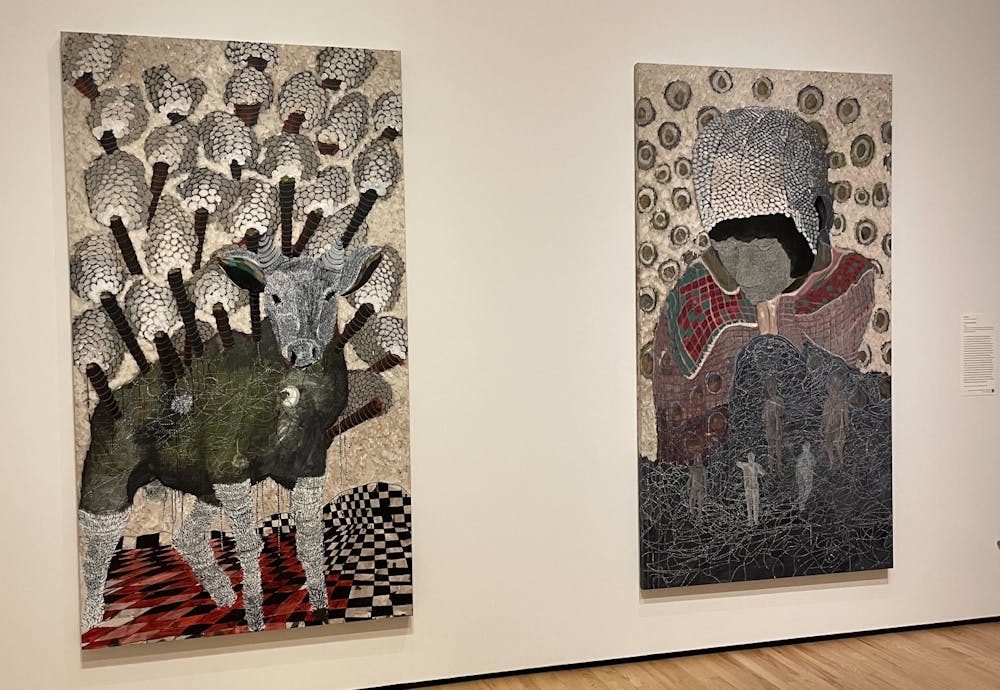If you appreciate sharp political commentary and bold visual design, I urge you to check out Political Animals at the Baltimore Museum of Art (BMA), on display through April 2. The exhibition showcases the eye-catching work of Senegalese artist Omar Ba, featured for the first time in a U.S. museum. The collection touches on themes of power, control, colonial legacies and the political nature of human beings. It inspires critical reflection on the relationship between people and their environment, between the powerful and the powerless, and between “the West'' and “the rest.”
Located in the museum’s Contemporary Wing, Political Animals is hard to miss. The exhibit presents 15 of Ba’s pieces on canvas and corrugated cardboard, 21 of his earlier works on paper and two modular paintings, including a mural he crafted specifically for installation at the BMA.
The grand scale, intense coloration and busy patterning characteristic of Ba’s oeuvre all stand out at first glance. He works on immense canvases and paints from a black base layer that pops out against the white gallery walls, endowing his art with a pronounced presence. Museum-goers will find themselves further drawn in by the vibrant pink and blue accents and repetitive geometric patterns that cover the canvas almost entirely, leaving minimal blank space.
Stylistically, Ba looks to local Senegalese culture for inspiration. He ventures into the capital city of Dakar with his camera, capturing youth culture and vibrant street market happenings. From his photographs, Ba selects people and animals that leap out to him, prints those images on colored paper and builds from there. Accordingly, you’ll notice that most of the canvases on show at the BMA portray human subjects, but his images contain much more than that.
The longer you sit with Ba’s work, the more complex it reveals itself to be. In terms of form, some paintings appear to incorporate feathers and beads for texture, but that dimensionality actually comes from Ba’s skillful use of multiple mediums. He combines wet and dry materials — including, but not limited to, oil and acrylic, watercolors, wax crayons and colored pencils — and experiments with color and opacity to construct layered images that warrant two or even three careful inspections.
Perhaps not surprisingly, given the name of the exhibit, Ba’s collection is not only an aesthetic feat but a political one too. Inspired by his upbringing in Senegal affected by Western-mandated fiscal austerity policies, Ba delivers a pointed political critique through his work. Most of his large-scale canvas pieces begin with a black foundation; in addition to generating a visual impact, this choice marks an intentional effort by Ba to subvert the inherent racism of a Western art canon that equates beauty with whiteness.
Ba further develops his political messaging by deliberately selecting his subjects and their presentation. He depicts African dictators, alludes to the United Nations and expresses other elements of Western-induced hardship. War imagery, national flags and maps show up in several pieces, prompting the audience to question the accepted world order, the dynamics of globalization and the implications of Western intervention.
With respect to his use of art to make a political statement, I appreciate the balance that Ba strikes between concrete and abstract representation. The imagery is defined enough to create a clear framework for his criticism but abstract enough that it leaves ample room for the viewer’s interpretation. This fine line is a difficult one to navigate, and so I applaud Ba.
In brief, Political Animals demonstrates the potential for art to serve as an avenue for political expression. Ba expertly manipulates color, form and subject matter to create attention-grabbing visuals that, upon closer study, reveal deeper insights that are informed by his own personal history. He makes a key contribution to the art world by distinguishing the Senegalese experience from the African experience broadly — providing nuance where nuance is long overdue — and speaks a visual language that is beyond compelling.
Whether you find yourself gravitating toward the aesthetic or the political dimension of Ba’s body of work, it is worth the short walk over to the BMA. Political Animals has left me grappling with questions of race, representation and global divisions propagated by our dominant political leaders — I hope it does the same for you.





